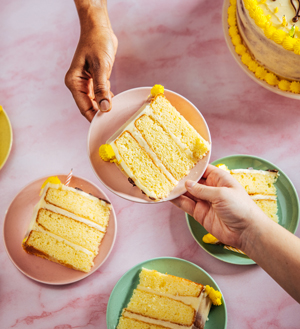Troubleshooting
Get Baking
Assuming you are working with a well-balanced formula, when a cake falls, peaks and cracks, or has poor texture, the first thing to consider is the oven temperature. The next is the proportion of ingredients (how they are weighed or measured). Incorrect substitutions without adjustments are often the problem; jumbo eggs instead of large, all purpose flour instead of cake flour without making necessary adjustment, as well as old baking powder can be a problem.
Assuming you are following directions precisely and have accurately weighed or measured the ingredients, the most common cake problems and causes are:
- Butter and sugar were not creamed together well enough before adding the eggs
- Eggs added too quickly
- Improper mixing procedure
- Improper cleaning and greasing of the pans
- Faulty baking conditions
- Improper cleaning of the equipment
- Out of date ingredients
- Uneven heat in oven
- Oven too full
- Oven temperature too high
- Baked too near sides of oven
- Inadequate air circulation in oven. Make sure the pan has at least 1- to 2-inches space between the sides of the oven and another pan, if using.
- If you have to bake two pans in the oven at once and they won’t fit on one shelf, stagger them between the two shelves.
- Too much leavening
- Insufficient creaming
- Use of liquid shortening
- Use of ordinary flour
- Oven temperature too low
- Batter under mixed
- Not enough liquid
- Too much flour
- Not enough fat
- Not enough sugar
- Too much flour
- Excessive mixing
- Oven temperature too high
- Over baking
- Batter too stiff (insufficient water)
- Batter too thin (excessive water)
- Too much sugar
- Damp flour
- Covering while still warm
- Over measurement of liquid
- Under baking – oven temperature too low and / or too short a baking time
- High humidity
- Too much sugar
- Under baking
- Damp flour
- Oven temperature too low
- Oven temperature too high
- Over baking
- Oven not hot enough
- Not enough sugar
- Not enough leavening
- Not enough shortening
- Old or too little baking powder
- Cold eggs
- Cold butter
- Too much flour
- Too much leavening
- Not enough shortening
- Not enough liquid
- Not enough sugar
- Over beaten egg whites
- Over baked or baked too long at too low temperature
- Over mixing the batter
- Pan too big
- Cooled cake in a drafty area
- Too much shortening
- Too much leavening
- Too much sugar
- Over or under mixing – too much or too little air is incorporated into batter
- Under baking – oven temperature too low and / or too short a baking time
- Too small of a pan
- Excessive jarring or moving of the cake during baking
- Opening the oven door before cake sets
- Too much shortening
- Too much leavening
- Too much sugar
- Cake taken out of the pan before it cooled enough
- Under baking
Low-grade flour
- Over mixing batter
- Too much shortening
- Not enough sugar
- The eggs were too small. Always use large eggs when baking.
- Insufficient air was whisked into the egg and sugar mixture
- The flour was not folded in gently. Always mix in the flour at the lowest speed. Too much liquid
- Too much flour
- Butter, sugar and eggs were not beaten together long enough
- Incorrect baking temperature
- Batter was beaten at too high a speed
- Over baking
- Under mixing
- Too much liquid
- Too many eggs
- Over mixing which caused too much gluten to form
- Oven temperature too high
- Too much flour or too little liquid
- Pan placed too high in oven
- Oven temperature too high
- Under mixing or extreme over mixing (over mixing produces too much gluten).
- Too much leavening
- Pieces were too large
- Batter was too thin to hold them
- Uneven heat in oven
- Oven grate not level
- Batter spread unevenly in pan
- Oven temperature too high
- Flour was not blended sufficiently into the main mixture
- Bent pans
- Too much batter in pan
- Oven not hot enough
- Too much leavening
- Too much shortening or sugar
- Under mixing
- Shortening too soft
- Not enough leavening
- Lower part of oven not hot enough
- Under beaten yolks
- Too much liquid
- Damp flour
- Moving the cake before it is set
- Under baking
- Cooling the cake in the pan
- Improper measurement of ingredients
- Too much sugar
- Pan not greased and floured enough
- Cooled too long in the pan before trying to remove it
- Under baked
Batter not sufficiently folded with beaten egg whites
Too much leavening
- Not enough shortening
- Not enough sugar
- Over mixing batter
- Oven too hot
- Over or under measurement of liquids
- Under mixing or extreme over mixing
- Too large of a pan
- Oven temperature too low or too high
- Not properly alternating the flour and the liquid ingredients during mixing
- Cold eggs and/or butter
- Expired or too little baking powder or soda to leaven the mixture
- Too much fat
- Incorrect amount of water
- Pans greased too heavily
- Pans too close together in oven
- Over baking – too long or at too high a temperature
- Improper mixing procedure


